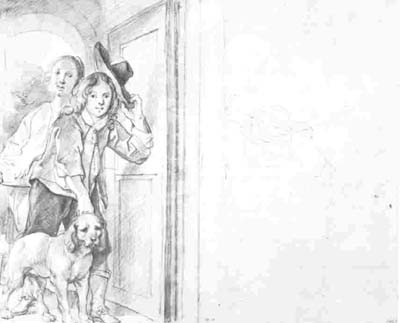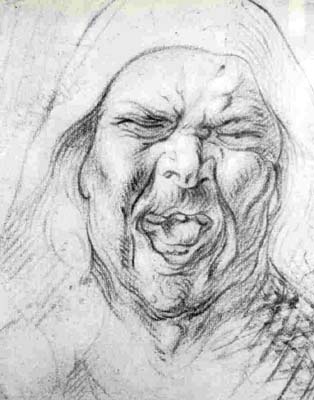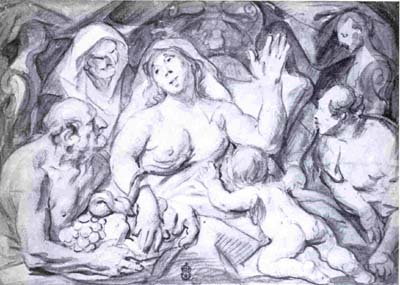
Bulletin 13, 1969
Home
Français
Introduction
History
Annual Index
Author &
Subject
Credits
Contact



Reflections on the Jordaens Exhibition
by
Michael Jaffe
Pages
1 | 2
| 3 | 4
| 5
| 6
| 7
| 8
| 9
| 10
| 11
| 12
The following observations
were made:
1 Jordaens developed early an obsessive dislike of wasting any paper
on which he could draw. This economy, since he was never a needy
man and became a rich one, was not dictated primarily by financial
stringency, but rather by psychological, perhaps even moral,
considerations. In that sense, he might even be held to have been
psychologically prepared to embrace Calvinism.
2 He seems almost to have preferred to work on a sheet pieced
together of scraps-whether by himself, his family or his pupils is
not known-either for painting or for drawing [e.g., Nos. 59, 82-84,
147, 158, 171], rather than take a whole fresh sheet. General exceptions to
this quirk appear to have been made for portrait studies
[e.g., Nos. 178, 179, 193], and for drawings which were to be
kept or sold as "show-pieces," virtually in their own
right [e.g., Nos. 187, 231]. As might also be expected, openings from
sketch-books remained integral [e.g., Nos. 131, 132].
3 He disliked trimming a deckle edge {did he make his own paper?).
Pristine edges show plainly, e.g., in Nos. 148, 218. For both these
drawings he pieced out his working surface to a suitable rectangle
by underlaying the deckle with a straight-edged piece. Such
augmentations are neither repairs nor later additions. Where his
main piece of paper had edges already cut, although irregularly
[e.g., Nos. 256, 258, 259, 262], he would likewise piece them out to
the desired size with additional strips. But again these
augmentations were made before he began drawing.
4 Occasionally he did add pieces of paper and draw on them,
after
his original drawing had been finished. This is particularly clear
when, in the 1660s, he chose to expand drawings resplendent in
water-colours [e. g., Nos. 222, 263], by strips worked more simply
in red and black chalks with ink used as wash or pen work.
5 Faced with some complicated problems in figure composition, he was
ready to use knife and paste for cut-outs and overlays [e.g., Nos.
167, 192, 223].
Notes on the Catalogue
General Introduction
In addition to what was said (p. 47) about the tributes paid by
Jordaens to Goltzius, mention should be made of Saenredam's 1596
engraving after Goltzius's WORSHIP OF CERES, as a likely source of
Jordaens's inspiration for undertaking the subject himself; see
below under Nos. 141 and 171.
The point might have been made, in discussing the predilection of
Jordaens for what was traditional in Flemish taste, that his zest
for depicting the illumination of an interior-particularly through
the reflections, on a wall, of sunlight filtered and shaped by
panes of glass-stems from his sharing his fellow countrymen's love
for Dürer's
ST.
JEROME IN HIS STUDY (B. 60). This was particularly
to be observed in the exhibition in "AS THE OLD SING, SO THE
YOUNG TWITTER" from Valenciennes [No. 65], and in the Stockholm
TELEMACHUS BRINGS THEOKLYMENUS TO HIS MOTHER PENELOPE [No.
180].
Something should have been said of the occasional late recrudescence
of High Renaissance ideals of axial bisymmetry and pyramidal
grouping in Jordaens's compositions, conspicuously in
THE HOLY
FAMILY EMBARKED [No. 105] of 1652; in
THE DEATH OF CLEOPATRA
[No. 107] of 1653; in the
Leningrad MARRIAGE GROUP [No. 106]; and later still in the
RESURRECTION modello at Ghent [No. 113], and in
CHRIST'S MIRACULOUS POWERS OF HEALING [No. 260] in its final form.
This taste is varied by the closely enmeshed configurations,
directed frieze-like to left or right, e.g., Nos. 109, 111, 112, 115
and 259, which are dated 1657 or datable thereabouts.
The name of Annibale Carracci should have been included on pp. 49,
50. In addition to the possible influence of Annibale which was
discussed in the entries for
THE BOATING PARTY [No.173] and
NEPTUNE
CREATING THE HORSE [No. 81], mention should have been made of the
possibility , discussed and illustrated by Professor J. S. Held in
his review of the exhibition in the Burlington Magazine, (6) that
Jordaens was inspired by Willem van Haecht's etching after
Annibale's
HOLY FAMILY EMBARKED for the "idea of the billowing
sail and the standing Christ Child in his own [Nos. 105, 245]."
Paintings
Introduction, p.67, n. 3: Agnew's 1817-1967, London, 1967,
illustrates this portrait, mistakenly as by Rubens. (7)
Next Page | Items
Exhibited 1 to 25
1 | 2
| 3 | 4
| 5
| 6
| 7
| 8
| 9
| 10
| 11
| 12
Annual Index | Author & Subject | Credits | Contact
This digital collection
was produced under contract to Canada's Digital Collections program,
Industry Canada.
"Digital
Collections Program, Copyright
© National Gallery of
Canada 2001"